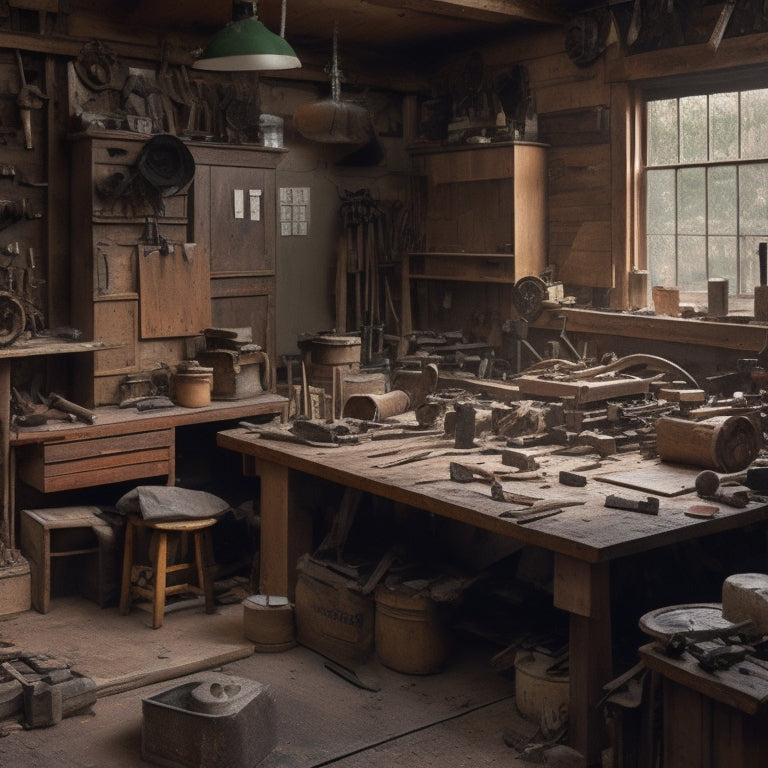
Why Woodworking Projects Always Take Longer Expected?
Share
You've probably started a woodworking project with a clear idea of how long it'll take, only to find yourself weeks or even months behind schedule, wondering what went wrong. It's likely because you underestimated the time needed, misjudged material quantities, or lacked experience with specific tools and techniques. Maybe you overlooked hidden tasks, like sharpening tools and preparing your workspace, or got sidetracked by non-essential tasks. Whatever the reason, it's clear that multiple factors contribute to project delays. To get back on track, identify the specific culprits in your project and adjust your approach – you'll find the solutions you need to get your project back on schedule.
Key Takeaways
• Unrealistic project timelines, inaccurate material estimations, and lack of experience often lead to woodworking project delays.
• Overlooking hidden tasks, such as tool maintenance and workspace preparation, can significantly add to project duration.
• Distractions and procrastination can cause woodworking projects to take longer than expected, making effective time management crucial.
• Complexity creep, where projects continually add new features or details, can increase project scope and duration.
• Inadequate project planning, including poor task allocation and unrealistic deadlines, can result in woodworking projects taking longer than expected.
Unrealistic Project Timelines
When you set out to tackle a woodworking project, you often underestimate the time it'll take to complete it, succumbing to unrealistic project timelines that can lead to frustration and disappointment. This mistake can be attributed to poor time management and inadequate project planning.
You might think you can finish a project in a weekend, but reality sets in when you're still working on it weeks later.
To avoid this, take a step back and assess your project's complexity. Break it down into smaller tasks and allocate realistic time frames for each one. Consider your skill level, the tools you have, and any potential roadblocks.
Create a schedule and stick to it, allowing for some flexibility in case things don't go as planned. Effective project planning involves identifying potential pitfalls and developing contingency plans.
Inaccurate Material Estimations
When you're planning a woodworking project, it's easy to misjudge the amount of material you'll need, leading to costly delays. You might think you've got enough lumber, only to find out you're short a few boards, or worse, you've got a bunch of scraps that won't fit together as planned.
Material Quantity Miscalculation
After meticulously planning your woodworking project, you're likely to encounter a common pitfall: underestimating the amount of material you'll need, which can lead to costly and time-consuming delays. This miscalculation can throw off your entire project timeline, affecting your time management and causing frustration.
Here are some common reasons why you might underestimate material quantities:
-
Measurement errors: A small mistake in measurement can result in a significant shortage of materials.
-
Design changes: Mid-project changes to your design can increase the amount of material needed, catching you off guard.
-
Inaccurate supplier information: Relying on supplier estimates or measurements can lead to errors if they're not accurate.
- Overlooking project scope: Failing to account for all aspects of the project, such as finishing materials or hardware, can result in material shortages.
To avoid these mistakes, take the time to double-check your measurements, plan for contingencies, and carefully review your project scope before ordering materials. By doing so, you'll minimize the risk of material shortages and keep your project on track.
Incorrect Cutting List
You've carefully planned your project, but if you don't accurately estimate the materials needed, your cutting list will be off, leading to more delays and wasted time.
Inadequate measurements can result in incorrect quantities, causing you to run short or have excess materials. This mistake can throw off your entire workflow, making it inefficient and time-consuming.
When creating your cutting list, double-check your measurements to guarantee accuracy. Take into account the actual dimensions of the materials you're using, including any defects or irregularities.
Don't rely on assumed measurements or rough estimates, as this can lead to errors. Instead, take precise measurements and calculate your material needs accordingly.
Lack of Experience Factors
Lack of experience with specific tools or techniques can greatly slow down your woodworking project, causing frustration and delays. As a beginner, you may not be familiar with the best practices or most efficient methods, leading to trial and error, which can be time-consuming.
This lack of experience can also lead to mistakes, requiring you to redo tasks, further slowing down your project.
To overcome this, focus on skill development by:
-
Practicing with different tools and techniques on small projects before tackling a larger one
-
Watching tutorials and online classes to learn new skills
-
Reading instructions and manuals carefully to understand the tools and materials
- Joining online communities or forums to learn from others' experiences
Overlooking Hidden Tasks
As you gain more experience and confidence in your woodworking skills, it's easy to overlook the smaller, behind-the-scenes tasks that can greatly impact your project's timeline.
You might think you've got a solid plan in place, but forgotten tasks can quickly add up and derail your project. It's vital to prioritize tasks effectively, making sure you allocate sufficient time for every step, regardless of its size.
When creating your project schedule, don't just focus on the main tasks, like cutting and assembling. Remember to factor in time for preparing your workspace, sharpening tools, and applying finishes. These hidden tasks might seem insignificant, but they can consume a significant amount of time if not managed properly.
Effective time management is critical here. Break down your project into smaller, manageable chunks, and allocate realistic timeframes for each task. By doing so, you'll avoid underestimating the time required for these hidden tasks and guarantee your project stays on track.
Tooling and Equipment Issues
When you're in the middle of a woodworking project, you expect your tools and equipment to perform as they should.
However, you've probably experienced times when your machine breaks down, or your tools aren't up to the task, causing frustrating delays.
It's crucial to identify and address these issues to get your project back on track.
Machine Breakdown Delays
Your woodworking project timeline is likely to take a hit when your machine or equipment suddenly breaks down, bringing your entire operation to a grinding halt. This unplanned downtime can be frustrating, especially when you're on a tight deadline. Machine breakdowns are a common occurrence in woodworking, and they can significantly delay your project's completion.
To lessen the impact of machine breakdowns, it's crucial to have a plan in place for maintenance scheduling and downtime management. Here are a few strategies to keep in mind:
-
Regularly inspect and maintain your machines to prevent breakdowns
-
Keep a spare inventory of critical parts and tools
-
Develop a backup plan for alternative equipment or outsourcing work
- Establish a relationship with a reliable repair service or technician
Insufficient Tool Quality
Using low-grade tools and equipment can greatly undermine the success of your woodworking project. This can lead to subpar results, wasted time, and increased frustration. You might think you're saving money by opting for cheaper tools, but in the long run, they'll cost you more time and effort. Dull blades, worn-out sandpaper, and faulty machinery can slow you down significantly. Additionally, they can also lead to accidents and injuries.
To avoid these issues, it's vital to invest in good-quality tools and maintain them regularly. Regular tool maintenance is essential to ensure they remain in top condition. Clean and lubricate your tools, and store them properly in your workspace.
A well-organized workspace is also crucial to your project's success. Keep your tools within easy reach, and make sure your workspace is clutter-free. This will save you time and reduce the likelihood of mistakes.
Distractions and Procrastination
Frequently, you find yourself sidetracked by non-essential tasks, which ultimately lead to procrastination, derailing your woodworking project's timeline. This is a common pitfall that can be avoided with effective time management and focus strategies.
When working on a project, prioritizing tasks and minimizing distractions is crucial.
Here are some common distractions to watch out for:
- Social media and email notifications
- Taking extended breaks to chat with family or friends
- Getting bogged down in research or planning, rather than taking action
- Continuously reorganizing your workshop or tools, rather than focusing on the task at hand
To overcome these distractions, try setting specific goals and deadlines for each work session. Use a timer to keep yourself on track, and take regular breaks to recharge.
Complexity Creep Phenomenon
As you dive deeper into your woodworking project, you may find yourself continually adding new features or intricate details, unaware that you're succumbing to the complexity creep phenomenon. This phenomenon occurs when you start with a simple idea, but as you progress, you keep adding more complexity, which ultimately increases the project's scope and duration.
It's vital to recognize when you're falling victim to complexity creep, as it can lead to project delays and burnout. To avoid this, revisit your original project planning and assess whether the added features align with your initial goals. Ask yourself, 'Is this addition necessary, or am I just trying to perfect every detail?'
Effective time management is pivotal in preventing complexity creep. Set realistic deadlines and allocate specific times for tasks. This will help you stay focused and avoid getting bogged down in minor details.
Frequently Asked Questions
Can I Still Make a Living as a Slow Woodworker?
You can still make a living as a slow woodworker by prioritizing time management, focusing on high-value woodworking projects, and optimizing your workflow to guarantee profitability, even with a slower pace.
Are There Any Shortcuts for a Beginner Woodworker?
"Imagine yourself efficiently sanding a smooth wooden surface. As a beginner woodworker, you'll want to invest in essential tools like a miter saw and clamps, while prioritizing safety precautions like goggles and a dust mask to avoid common hazards."
How Do I Deal With Frustration During a Project?
When frustration hits, you're not alone; take a deep breath, step back, and reassess. Managing stress and staying motivated is key - try coping strategies like mindfulness techniques, breaks, and reframing setbacks as opportunities to learn and grow.
Can I Reuse Old or Reclaimed Wood for Projects?
"Did you know that up to 30% of urban waste is wood waste? You can reuse old or reclaimed wood for projects, but consider the wood quality and its impact on sustainability, while balancing design creativity with limitations."
Are There Any Woodworking Projects Suitable for Children?
When introducing kids to woodworking, you'll want to prioritize safety precautions and parental supervision. Start with simple projects, like birdhouses or picture frames, using softwoods and kid-friendly tools to guarantee a fun, accident-free experience.
Related Posts
-

Heavy-Duty Pegboard Hooks for Industrial Use
You need heavy-duty pegboard hooks that can withstand the rigors of industrial use, providing a reliable and efficien...
-

Heavy-Duty Commercial Rolling Shelving Racks
You need heavy-duty commercial rolling shelving racks that optimize your storage capacity, streamline operations, and...
-

Benefits of Pegboard Racks in Your Garage
By installing a pegboard rack in your garage, you'll reveal a wealth of benefits that change your workspace into a hi...


